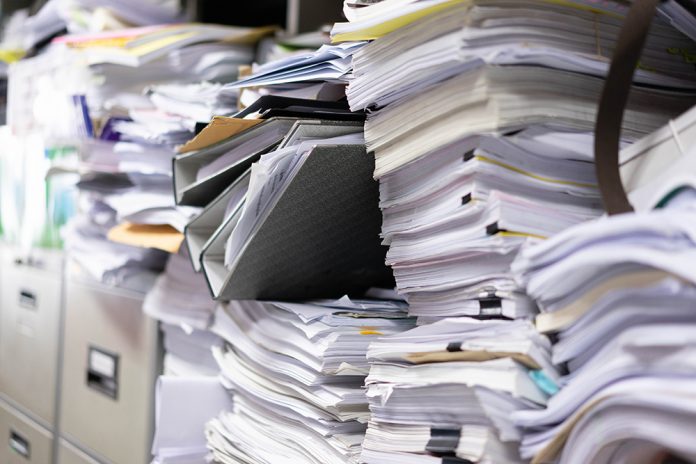Does your organization have offices, file cabinets, storage rooms, and offsite facilities full of unidentified paper files and electronic documents? If so, you probably have an “information toxic dump!” Twenty-five years ago most organizations had a “central filing system” and “Mabel” – whose sole responsibility was ensuring that the records that the organization needed for legal reasons were maintained properly. Managers had private secretaries who were paid to make sure that when their bosses were done with the papers in their office, they were transferred (with the help of file clerks) to the central filing system. The central filing system was purged on an annual basis.
Then Bill Gates made it possible for organizations to put a computer on every desk, and the dynamics of records management changed dramatically. “Mabel” and the file clerks were fired or transferred to other positions. Central File Rooms were turned into offices. The file cabinets were scattered around offices wherever there was space – supply rooms, hallways, and individual offices. Managers were expected to manage their own information and do their own filing. Secretaries became administrators with projects of their own. Soon, records management as it existed began to disintegrate!
Records management today
Today in most offices, information exists in three “silos” of information:
- Individual offices
- File cabinets scattered around the office
- Office storage rooms and offsite filing facilities
The information in individual offices is managed somewhere between very well or very poorly – depending on the skills of the individual employee – but in any case is rarely available to other members of the organization should the employee who has the information, or filed it, be unavailable.
The information in file cabinets scattered around the office is “owned” by no one in particular. Theses file cabinets primarily contain files no longer needed by individual employees, or left by employees who are no longer there. Even though they often contain information that could be useful, individual employees don’t know it exists, and thus end up creating new information. The information in storage rooms and offsite filing facilities contains vital information that could save money, or cost millions of dollars in the case of an audit or lawsuit. Unfortunately, offsite storage often contains information that should never have gone there, but no one wanted to take the time or effort to clean it out!
Why records management really matters
Your ability to accomplish any task or goal is directly related to your ability to find the information you need when you need it. Finding information in every organization – regardless of whether it is in paper or electronic format – is becoming an ever-increasing challenge. This inability to find information causes all sorts of problems for the organization and for the individual – wasted time looking for information or recreating already-existing information, missed opportunities, and increased stress, which in turn results in increased health care costs.
Research shows that 80% of the information kept in most offices is never used. Ironically, the more information that is kept, the less it is used, simply because it’s too difficult for employees to find. Often employees can’t even find the documents they themselves created – let alone any information created by another employee – especially someone who is no longer with the organization. As a result, it’s easier to just start over!
Who is responsible for the problem and what can be done about it?
Blame for the records management debacle falls in several courts:
- Management blames employees for the problem.
- Employees blame management for the problem.
- Organizations don’t have a user-friendly system.
- Employees aren’t trained on the filing systems.
- Management fails to look at records management as an ongoing activity.
To create and maintain an effective records management program, we must answer the following six questions:
- What information should we keep?
- In what form?
- For how long?
- Who is responsible for maintaining the information?
- Who needs access to the information?
- How can everyone who needs the information find it?
Now here is the reality: Answering those six questions requires the cooperation of everyone in the organization. It can easily take up to one year, or even longer, to answer them, since accuracy requires addressing the questions over a one-year business cycle at a minimum.
Creating and maintaining an effective records management system
I’ve developed a five-step process called The Productive Environment Process™, which can be applied to organize information in any organization.
- State your vision. If your records management program is successful, what will you be able to do that you can’t do now? What positive effect will an efficient records management program have on the organization and your customers?
- Identify your obstacles. What currently prevents you from having a successful system?
- Commit your resources. How much time, money, and human resource power are you willing to put into the project?
- Design your SYSTEM (Saving You Space Time Energy Money). What tools (software, existing filing systems that work well, etc.) do you currently have that will be helpful in the process? What other tools are available? What processes do you need to apply? A crucial component is applying The Art of Wastebasketry® to eliminate unnecessary records.
- Maintain your success. What procedures do you need to develop and implement so the system you create will continue to work long after the creators of the system are gone?
Note the common word in those five steps: “Your!” It would be wonderful if creating a records management system was simply a matter of buying a book or hiring an expert who told you exactly what to do. A successful records management program, however, requires people, processes and technology. It must be supported by management, customized for the organization, and executed by everyone in the organization to succeed on an ongoing basis.
According to an article in the July 2010 issue of Journal of Accountancy, a paperless strategy can yield savings of 30% to 40%. Some of the savings comes from reduced overhead costs, such as what you spend on paper or real estate expenses, while others come from the increased efficiency of working digitally. Every firm is different and the extent to which it goes digital varies, but a paperless strategy will reduce costs and improve profitability, even in ways firms haven’t considered up front.
Designing, implementing, and maintaining an effective records management program is the best place to start on the road to a “productive environment™” – an organized office in which everyone can find what they need when they need it so they can accomplish their work and enjoy their lives.
As Mark Twain stated so eloquently, “Progress starts with the truth.” The first step is for management to agree on the definition of a successful records management program. It is important that this conclusion be reached with the involvement of administrative staff – because the reality is that often management doesn’t really understand all the information that is necessary for staff to accomplish the objectives that management expects.
© Barbara Hemphill 2010-2018
Trademarks and Registrations are the property of Barbara Hemphill


Barbara Hemphill
Barbara Hemphill is one of the country’s leading productivity experts, and is passionate about helping individuals and organizations create and sustain a productive environment. She is author of the best-selling “Taming the Paper Tiger” book series. In “Bushido Business,” Barbara joins Tom Hopkins, Brian Tracy & Stephen M. R. Covey, sharing how they learned how to be successful. Her latest book is “Less Clutter More Life.” To contact Barbara Hemphill about speaking or consulting for your organization:
[email protected]







